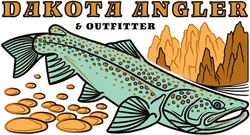Beginning Fly Tying Part II
We have filmed quite a few fly tying videos over the the past few years. Many of those videos are perfect for beginning fly tiers. In this post we share some of our favorite videos for beginners starting with the easiest pattern to tie.
Be sure to check out the first post in the Beginning Fly Tying Series where we discussed the basic tools needed for beginning tiers.
Beginning Fly Tying Part I
More Beginning Fly Tying Videos Coming Soon!
Fly Patterns for Beginning Fly Tying
Mercury Midge
Tying the Mercury Midge
The mercury midge is the same pattern tied in the Wapsi Zebra Midge Kit. The traditional zebra midge is in the next video. They are very similar patterns. The Mercury midge uses a glass bead while the zebra midge uses a brass or tungsten bead. Either way, these are great flies to begin your fly tying adventure. The Mercury Midge works just about anywhere trout live. So if you sit down and tie up 50 of them you will be guaranteed to use them. The great thing about mercury midges for learning to tie flies is that they teach you how to wrap thread neatly, wrap a material on a hook, and how to whip finish. If you need to learn to use your whip finisher, we have a video for that too!Materials needed to tie the Mercury Midge
- Hook: Curved Emerger or Scud Hook - Tiemco 2457, Tiemco 2487, Daiichi 1130, Daiichi 1120, Lightning Strike SE1. Sizes 16-22
- Bead: Small Glass Bead - Iridescent or Pearl*
- Thread: 70 Denier Ultra Thread - Cream *
- Rib: Small Ultra Wire - Copper Color *
Zebra Midge
https://www.youtube.com/watch?v=ZVMgamNov5c The zebra midge is very similar in many ways to the mercury midge above. The zebra midge in this video has a bit of a taper added to the body from lead wire. However, adding the lead wire is optional. Tie it the same as you would the glass bead midge but with a brass or tungsten bead. The brass and tungsten bead versions are heavier and will sink more quickly. The Zebra midge is frequently tied in this black and silver version, but it also works very well in red and silver, tan and silver, and olive and copper. All that is needed is changing thread and wire color to create any variation that you wish. Tie this fly in sizes 16-22.Materials needed to tie the Zebra Midge
- Hook: Curved Emerger or Scud Hook - Tiemco 2457, Tiemco 2487, Daiichi 1130, Daiichi 1120, Lightning Strike SE1. Sizes 16-22
- Bead:Silver or Nickel Brass or Tungsten Bead **
- Thread: 70 Denier Ultra Thread*
- Rib: Small Ultra Wire
Skinny Nelson
https://youtu.be/C3JwAZICvm8 The Skinny Nelson is a hybrid between a zebra midge and a flashback pheasant tail nymph. It makes a transition for a beginning fly tier from tying the two midge patterns above to tying a more traditional nymph pattern. In this fly beginning tiers will learn how to tie in materials other than wire. In addition to being a simple nymph to tie, the Skinny Nelson is also a very effective fishing fly. You can tie this pattern without a bead as shown in the video, however if you wish to add a bead to the fly we suggest tying it with a black nickel tungsten bead.Skinny Nelson Materials
- Hook: Short Shank Nymph Hook - TMC 3769, Daiichi 1560
- Thread: 70 Denier Black Thread
- Tail: Black Hackle Fibers
- Rib: Small or X-Small Silver Wire
- Flashback/Wingcase: Pearl Tinsel Medium Width
- Thorax: Peacock Herl
Pheasant Tail Nymph
https://www.youtube.com/watch?v=2yC8F6OXiGM The pheasant tail nymph is a classic nymph pattern. It has been around for more than 70 years and it continues to fool trout around the world. Learning to tie this pattern involves slightly more skill than the Skinny Nelson above. Tying in and wrapping the pheasant tail fibers for the tail and body will prepare you for working with a variety of new materials to come. Start tying this in larger sizes such as a 12 until you can comfortably work with the pheasant tail fibers. Gradually tie them smaller and smaller. Eventually you will have no problem tying size 18s or even 20s. Remember, the smaller the hook size the less material you will need. Meaning when tying a size 12 pheasant tail nymph you will need more pheasant tail fibers to create the body (maybe 7-10). On a size 16 you will need a few less, and an 18 or 20 even fewer. This all takes practice but you learn something with every fly that you tie. And remember even ugly flies catch fish!Pheasant Tail Nymph Materials
- Hook: Short Shank Nymph Hook - TMC 3769, Daiichi 1560 size 12-22
- Thread: 70 Denier Brown Thread
- Tail: Pheasant Tail Fibers
- Rib: Small Copper Wire (use x-small wire on sizes 18-22)
- Abdomen:Pheasant Tail Fibers
- Wingcase: Pheasant Tail Fibers
- Thorax: Peacock Herl
Hare's Ear Nymph
https://www.youtube.com/watch?v=4-Bw35m1fhY The Hare's Ear nymph is another classic nymph. It has been around seemingly forever and yes it still catches loads of fish. The hare's ear is the first video in this series that uses dubbing. Dubbing is loose fur or fibers that get twisted onto the thread to create a thicker rope. This is wrapped onto the hook to create the body of the fly. Working with dubbing can be tricky. We have a video on how to apply dubbing that can be helpful. https://www.youtube.com/watch?v=wuScJXLyh78&feature=youtu.beMaterials needed to tie the Hare's Ear Nymph
- Hook: Short Shank Nymph Hook - TMC 3769, Daiichi 1560
- Thread: 70 Denier Brown Thread
- Tail: Fox Squirrel Guard Hairs
- Rib: Small Oval Gold Tinsel
- Abdomen: Hare's Ear Dubbing
- Wingcase: Turkey Tail Fibers
- Thorax: Hare's Ear Dubbing
More Beginning Fly Tying Videos Coming Soon!





